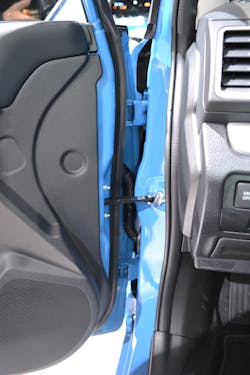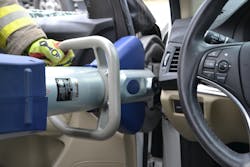Topic: Door-removal efficiency
Objective: Maximize the door-removal task
Task: The rescue team shall review its door-removal techniques to assure maximum efficiency
At a crash scene where occupants are trapped, it’s common to have rescue personnel force open a jammed door and then widen it or remove it entirely. Door removal typically is completed by either prying off the door with a spreader or cutting it off with a power cutter, air chisel or reciprocating saw.
As rescuers, we don’t want any one task to take an unnecessarily long period of time to accomplish, and door removal is no exception. If minutes are going by and the crew is struggling to remove an opened door while others are standing around waiting, then probably something is wrong.
The reason that door removal is desired to be done in as short a time as possible is because during door removal, other extrication tasks can be held up. Just the effort to remove an opened door in and of itself can interfere with other tasks being completed simultaneously by EMS or rescue personnel near a trapped occupant.
The fastest tactic
Rescue crews have a choice when it comes to total door removal. The task can be accomplished by breaking the hinges with a power spreader or cutting through everything that attaches the door to the vehicle.
Removing a door by cutting it off usually is faster and less violent than forcing off the door at the hinges. Even with both hinges fractured, the vehicle door still might remain attached to the vehicle.
Let’s consider a door-removal scenario via a power cutter (probably the fastest tactic). There’s a recommended thought process that can be introduced during training and carried through to real-world incident situations: accomplish the task without wasting valuable time.Time savings begin when the tool operator is trained to initially determine how many points of attachment hold the door to the vehicle. Whatever the number, the goal is to remove the door with fewer cuts than the number of points of attachment.
For example, a typical late-model automobile door is secured at four points: the two hinges, the door retainer bar and an “umbilical cord” wiring harness. Rescuers should consider how they can utilize the power cutter to cut off the door in three cuts or, maybe, even two.
By figuring out a way to cut through two or three items with one cut, the overall time to remove the door is shortened.
With a full-size power cutter, the tool operator might be able to grab the flexible wiring harness with one blade and cut it at the same time that both of the blades close down and cut through the door retainer bar and even one of the two hinges. After that, cutting the remaining hinge would allow the door to come off.
To get in the mindset of cutting off the door in fewer cuts than the number of points of attachment to the vehicle, the tool operator also should be trained to approach the opened door with the blades of the power cutter opened as wide as possible. Seeing the width of the blade opening gets the operator thinking of how he/she can make one cut to potentially disconnect multiple connections to the vehicle. Once in the correct position and with the tool pointed at the attachment points, the placement of the tool can be finalized.Touch points
At an extrication scene, your effectiveness should be measured by how efficiently you accomplish your tasks to free trapped vehicle occupants, not how long you are on scene.
An untrained civilian could remove an automobile door using a power cutter but probably would make a cut at each point of attachment. Let’s try to be professional and efficient and cut a door free in fewer cuts than there are attachment points, ideally in the bare minimum of two cuts.
Consider this training concept the next time that you’re confronted with a door-removal assignment. How many attachment points are there? Can you cut off the door in fewer cuts than the number of attachment points? If you accomplish that, then you’re maximizing your efficiency.
Sidebar 1 of 1
Door Removal—Power Cutter vs. Attachments:
- Open door fully
- Determine number of attachment points
- Determine tactic to make fewer cuts than attachments
- Make minimum number of cuts required
- Remove door from vehicle
About the Author
Ron Moore
RON MOORE, who is a Firehouse contributing editor, recently retired as a division chief with the McKinney, TX, Fire Department and now serves with Prosper, TX, Fire Rescue. He self-published the Vehicle Rescue 1-2-3 training manual and serves as the forum moderator for the extrication section of Firehouse.com . Moore can be contacted directly at [email protected].



